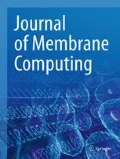Abstract
We study the notion of memory associated with membranes systems. Such a memory can be used in various ways; in this paper, we focus on two of them. One way is to consider the memory as a device for tracking how objects evolve. In this perspective, the memory is coded into objects which are enriched with suitable information to keep track on how they have been produced. This kind of memory allows to study the reversibility of membrane evolution. Another way is to consider the memory as a storing device for the objects consumed previously in the same evolution step. This kind of memory allows to describe a dynamic allocation of objects; two semantics are presented (a dynamic one and a static one), and it is proved their equivalence.



Similar content being viewed by others
References
Agrigoroaiei, O., & Ciobanu, G. (2009). Rewriting logic specification of membrane systems with promoters and inhibitors. Electronic Notes of Theoretical Computer Science, 238, 5–22.
Agrigoroaiei, O., & Ciobanu, G. (2010). Reversing computation in membrane systems. Journal of Logic and Algebraic Programming, 79, 278–288.
Aman, B., & Ciobanu, G. (2009). Turing completeness using three mobile membranes. Lecture Notes in Computer Science, 5715, 42–55.
Aman, B., & Ciobanu, G. (2011). Mobility in Process Calculi and Natural Computing. New York: Springer.
Aman, B., & Ciobanu, G. (2017). Reversibility in parallel rewriting systems. Journal of Universal Computer Science, 23, 692–703.
Aman, B., & Ciobanu, G. (2019). Adaptive P systems. Lecture Notes in Computer Science, 11399, 57–72.
Aman, B., & Ciobanu, G. (2019). Synchronization of rules in membrane computing. Journal of Membrane Computing, 1, 233–240.
Aman, B., Ciobanu, G., Pinna, G. M., et al. (2020). Foundations of reversible computation. Lecture Notes in Computer Science, 12070, 1–40.
Ciobanu, G. (2010). Semantics of P systems. In The Oxford Handbook of Membrane Computing (pp. 413-436). Oxford University Press.
Ciobanu, G., Marcus, S., & Păun, G. (2009). New strategies of using the rules of a P system in a maximal way. Romanian Journal of Information Science and Technology, 12, 21–37.
Ciobanu, G., & Pinna, G. M. (2012). Catalytic Petri nets are Turing complete. Lecture Notes in Computer Science, 7183, 192–203.
Ciobanu, G., & Pinna, G. M. (2014). Catalytic and communicating Petri nets are Turing complete. Information and Computation, 239, 55–70.
Ciobanu, G., & Todoran, E. N. (2017). Denotational semantics of membrane systems by using complete metric spaces. Theoretical Computer Science, 701, 85–108.
van Glabbeek, R. J. (2005). The individual and collective token interpretation of Petri nets. Lecture Notes in Computer Science, 3653, 323–337.
Giachino, E., Lanese, I., Mezzina, C.A., Tiezzi, F. (2015). Causal-consistent reversibility in a tuple-based language. In M. Daneshtalab, M. Aldinucci, V. Leppänen, J. Lilius, M. Brorsson (Eds.) PDP 2015 (pp. 467–475). IEEE Computer Society
Kleijn, J., & Koutny, M. (2009). A Petri net model for membrane systems with dynamic structure. Natural Computing, 8, 781–796.
Kleijn, J., Koutny, M., & Rozenberg, G. (2005). Towards a Petri net semantics for membrane systems. Lecture Notes in Computer Science, 3850, 292–309.
Lanese, I., Mezzina, C. A., & Tiezzi, F. (2014). Causal-consistent reversibility. Bulletin of the EATCS vol. 114
Păun, G. (2002). Membrane Computing. An Introduction. New York: Springer.
Păun, G., Rozenberg, G., & Salomaa, A. (2010). The Oxford Handbook of Membrane Computing. Oxford: Oxford University Press.
Pinna, G. M. (2017). Reversing steps in membrane systems computations. Lecture Notes in Computer Science, 10725, 245–261.
Pinna, G. M., & Saba, A. (2012). Modeling dependencies and simultaneity in membrane system computations. Theoretical Computer Science, 431, 13–39.
Zhang, G., Pérez-Jiménez, M. J., & Gheorghe, M. (2017). Real-Life Applications with Membrane Computing. New York: Springer.
Acknowledgements
The authors would like to thank the reviewers for their useful criticisms and suggestions.
Author information
Authors and Affiliations
Corresponding author
Ethics declarations
Conflicts of interest
The authors declare they have no financial interests, and have no conflicts of interest.
Additional information
Publisher's Note
Springer Nature remains neutral with regard to jurisdictional claims in published maps and institutional affiliations.
The initial work was presented at the 20th Conference on Membrane Computing (CMC20)
Rights and permissions
About this article
Cite this article
Ciobanu, G., Pinna, G.M. Memory associated with membranes systems. J Membr Comput 3, 116–132 (2021). https://doi.org/10.1007/s41965-020-00066-8
Received:
Accepted:
Published:
Issue Date:
DOI: https://doi.org/10.1007/s41965-020-00066-8



